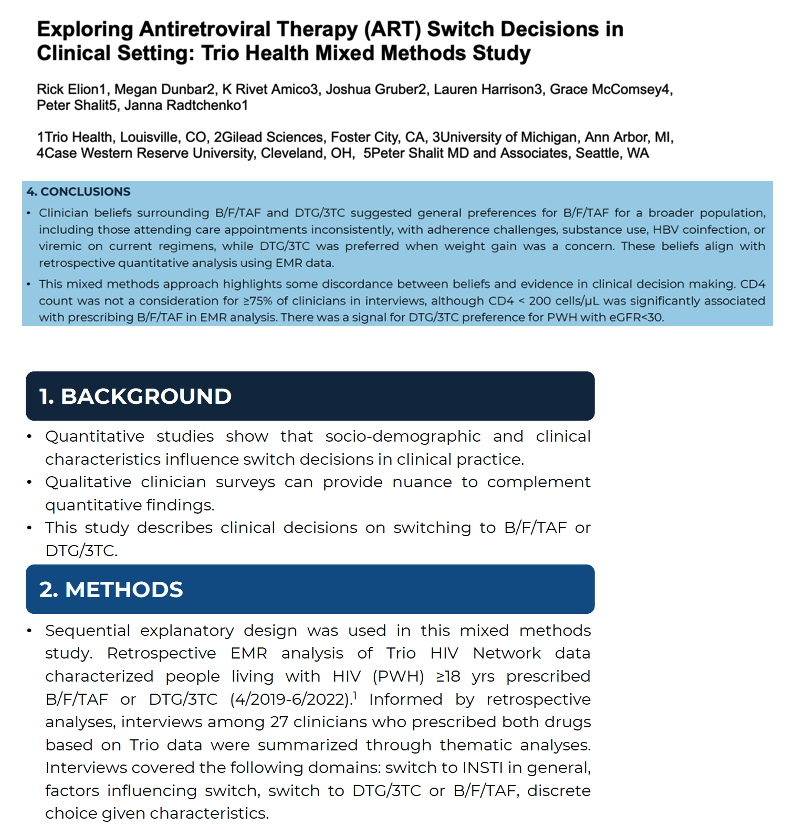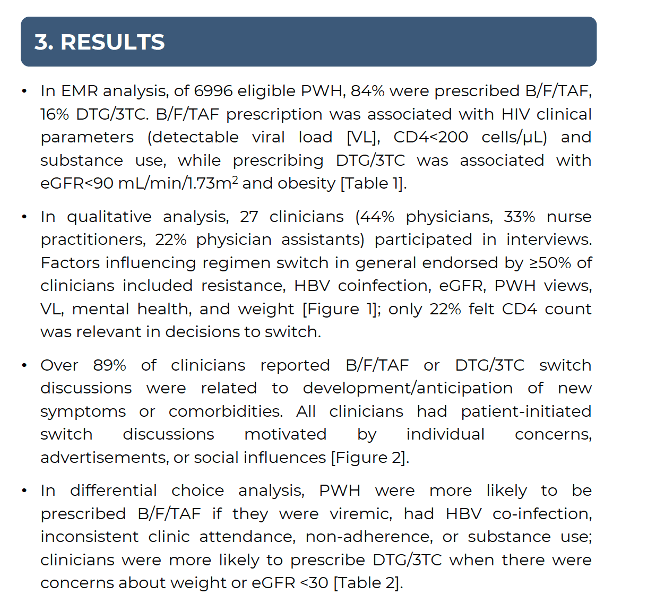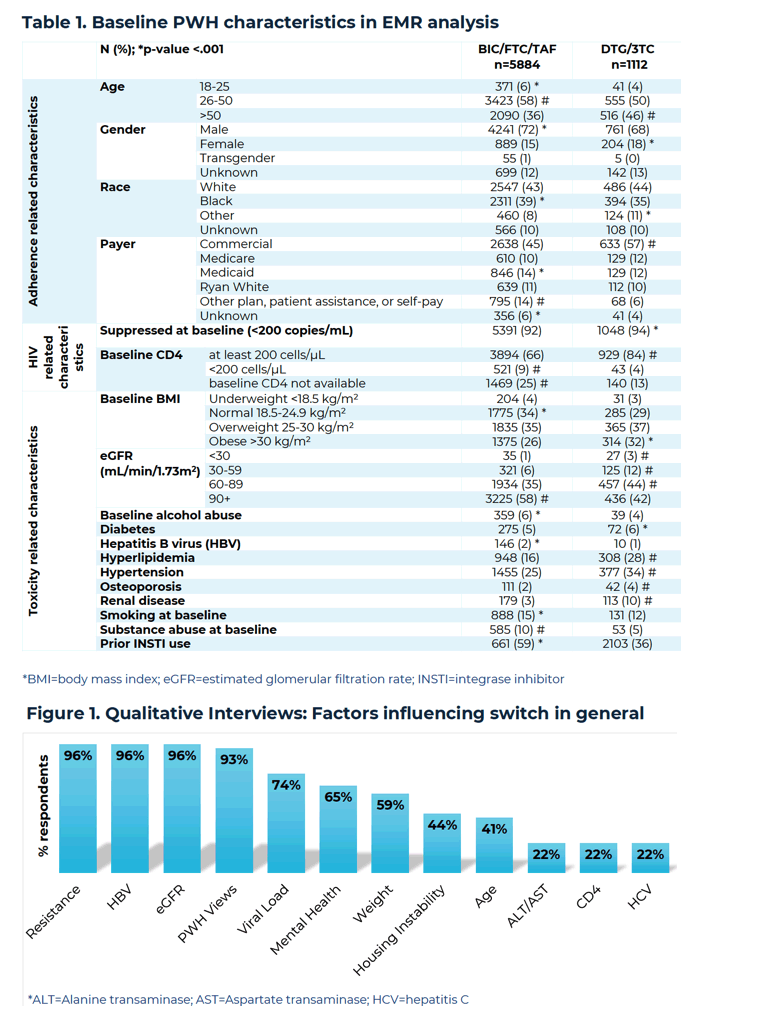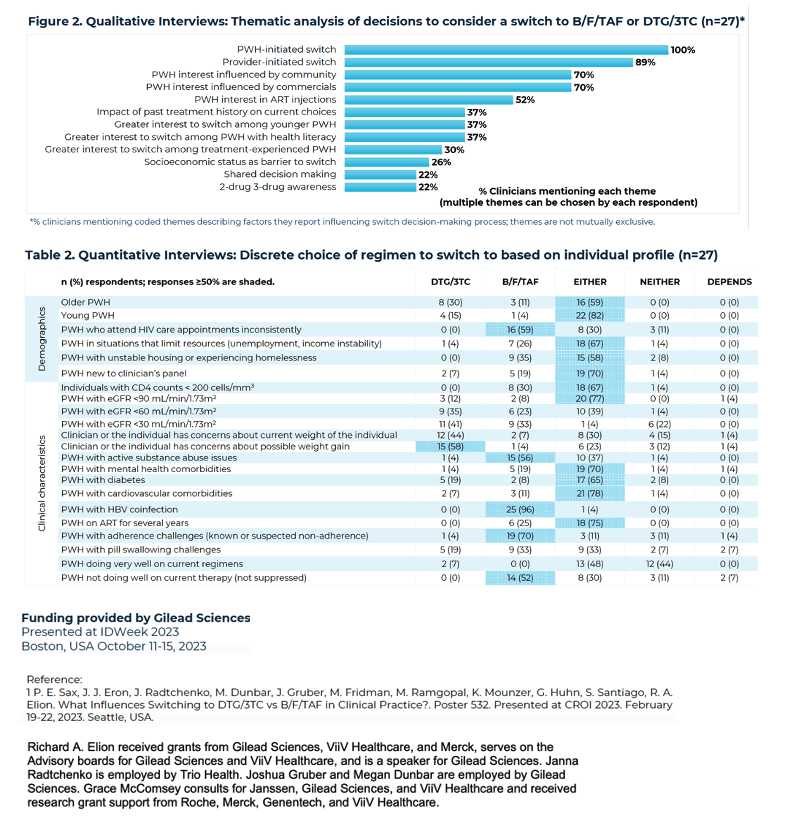 |
 |
 |
| |
Reasons Differ for Switch to DTG/3TC (Weight Concern)
and B/F/TAF (Adherence, Substance Abuse, Poor HIV Control)
|
| |
| |
IDWeek 2023, October 11-15, 2023, Boston
Mark Mascolini
People taking antiretroviral therapy (ART) switch to integrase inhibitor regimens containing dolutegravir (DTG) or bictegravir for distinct reasons, according to a mixed-methods analysis of electronic medical records and interviews with 27 clinicians who prescribed both drugs in the Trio HIV Network [1]. Concern about possible weight gain drove switches to DTG/3TC, while switching to bictegravir/FTC/tenofovir alafenamide (B/F/TAF) proved more frequent in people with inconsistent appointment keeping, ART adherence challenges, active substance abuse, HBV coinfection, or a current failing regimen.
With colleagues at other US centers, Rick Elion of Trio Health conducted this study of 6996 adults who switched to DTG/3TC of B/F/TAF from April 2019 to June 2022. The researchers planned quantitative and qualitative interviews with 27 clinicians who prescribed switches to both of these integrase inhibitor combinations to people in this study group. They used electronic medical records to gather relevant data on study participants and differential choice analysis to home in on distinct reasons people changed their ART to DTG/3TC or B/F/TAF.
Among 6996 people with HIV, clinicians prescribed a switch to B/F/TAF for 84% and to DTG/3TC for 16%. Of the 27 clinicians, 44% were physicians, 33% nurse practitioners, and 22% physician assistants. In qualitative interviews more than half of these clinicians cited seven factors that influenced changing to an integrase inhibitor in general: resistance to antiretrovirals (96%), HBV infection (96%), estimated glomerular filtration rate (eGFR) (96%), views of person with HIV (93%), viral load (74%), mental health (65%), and weight (59%).
Comparison of baseline characteristics in people who traded their current regimen for B/F/TAF versus DTG/3TC linked a B/F/TAF switch to a detectable viral load, a CD4 count below 200, and substance use, whereas obesity and eGFR below 90 mL/min (indicating suboptimal kidney function) drove switching to DTG/3TC.
In qualitative interviews, 9 in 10 clinicians said discussion of switching to DTG/3TC or B/F/TAF reflected development or anticipation of new symptoms or comorbidities. All clinicians reported patient-initiated discussion of switching spurred by individual concerns, advertisements, or social influences.
Discrete choice analysis pinpointed clinician beliefs that drove switching to one regimen but not the other. Clinician or individual concern over possible weight gain emerged as the only factor associated with switching to DTG/3TC but not B/F/TAF (58% of respondents for DTG/3TC vs 4% for B/F/TAF). Five clinician beliefs favored switching to B/F/TAF but not DTG/3TC: inconsistent appointment attendance (59% vs 0%), known or suspected antiretroviral nonadherence (70% vs 4%), active substance abuse (56% vs 4%), HBV coinfection (96% vs 0%), and detectable viral load with current regimen (52% vs 0%).
The researchers concluded that clinician beliefs involving B/F/TAF and DTG/3TC suggested preference of B/F/TAF for a wider population. They noted that these beliefs align with retrospective analysis of electronic medical record data. CD4 count below 200 was an exception to this trend: Low CD4 count did not emerge as a switch factor in the discrete analysis of clinician interviews, but baseline electronic medical records did link it to prescribing B/F/TAF.
Reference
1. Elion R, Dunbar M, Amico R, et al. Exploring antiretroviral therapy (ART) switch decisions in clinical setting: Trio Health mixed methods study. IDWeek 2023, October 11-15, 2023, Boston.




|
| |
|
 |
 |
|
|